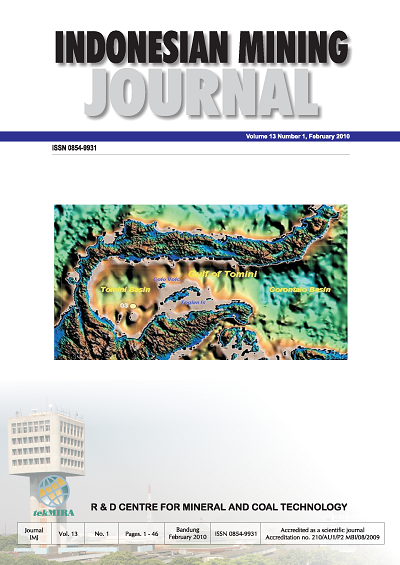Indexed by:
Vol. 13 No. 1 (2010): INDONESIAN MINING JOURNAL Vol. 13 No. 1 February 2010

The study about regional regulation on mineral and coal mining sector is significant due to some considerations: a). What have been done by regions to their regional regulations on mining, as it is in line with the policy that is stated in Law Number 4 Year 2009. The regulations are decentralistic and refer to the legal procedure, and b). The substance of the study is an evaluation to the material violation by the regulations in various regions towards several higher-level regulations. The existence of Law Number 4 Year 2009 surely brings different atmospheres, and potentially results in opportunity for different kind of violation by the regulations issued by provincial, regency and city governments. This situation must be observed and analyzed for prevention. This has to be realized that any violation to regional regula- tion on mining will cause consequences to the development of mineral and coal mining business in the future.
Common issues on the mineral and coal mining sector in Indonesia are mainly caused by the centralistic policy instruments and the regional autonomous principles, which are not accommodated yet by the central government. Moreover, the rate of the mining investment is low due to the inconsistent regulations, particularly relating to the management aspects for the forest sector, spatial uses, environment and the central-regional authority sharing. Interest conflicts of using land, security, illegal mining cause the mining investment that is very low. Accordingly, supply of the products of the mineral and coal commodities for the domestic needs automatically decline.
The objectives of establishing the new law for the mineral and coal mining business, hopefully, can manage the policy of exploitation of the resources, which can anticipate the opportunity and the challenge in the more prosperous future in this sector. In addition, this new law can provide the law warranty and protection to the stakeholders/mining businessmen, so they have the opportunity to increase interest and investment values in the mining sector, which could optimally improve the national and regional revenues.
Six papers are presented in this current journal, because they have indicated to support the implementation of the above new mining law; particularly for the first paper that focuses on the analysis of the regional regulations on mineral and coal mining sector. Surveys on eight provinces clearly indicate the increase of regional revenue without taking into consideration of the existing legal principles. This condition led to an unconducive business climate that could hinder the economic growth and the investment opportunity. The presence of the new mining law is really expected to be able to cope with those issues. Analysis on the law reveals that the law requires to be clarified by implementing regulations that have not been issued. R&D on catalyst derived from minerals for coal liquefaction reaction remains attractive as Indonesia has various kinds of minerals that are suitable to be used as catalyst precursors. For this reason, iron ore from South Kalimantan and tailing of PT. Freeport were examined their activities to obtain the most appropri- ate catalyst precursors for coal liquefaction reaction. The result shows that the tailing resulted in lower oil yield and coal conversion than those of iron ore. The chemical composition of West Kalimantan bauxite has been extracted to produce alumina and bauxite residue (red mud). The aim of the research is to produce hydrated alumina from bauxite residue by soda-lime sintering process as raw materials for the making of alums and poly aluminum chloride. It also produces iron concentrate from residue of leaching as a by-product. Preparation of meso porous silica from bentonite was carried out by ultrafine grinding and leaching. This bentonite contains montmorillonite with porous structure. The ultrafine grinding was conducted by using planetary ball mill in wet condition in methanol. The leaching process produced porous silica material with meso porous. This is a special characteristic to be used in various applications of industry. Well-known applications of porous material are adsorbent, filter and catalyst; while developing applica- tions are being conducted for hydrogen storage in fuel cell technology and waste treatment. Barium concentrations of trace elements in the sediments core from the Tomini Basin were assessed to establish their vertical distribution and occurrence. The highest concentration is barium indicating that its composition in the surface sediments generally increases downward. Vertical distribution of barium in the basin shows that its sedimentary environment has a high palaeo-productivity. The preliminary study of co-processing coal with used tire and asphalt in coal liquefaction was carried out. To utilize these hydrocarbons and to develop coal utilization, they change as co-processing in coal liquefaction. The objective of the study is to find out the hydrocarbon material in cooperation with coal in the coal liquefaction to obtain high conversion and oil product. The result indicates that the synergy between coal and used tire and asphalt occurred and the percentage of conversion increased.
After reading and assessing all the above papers, it is really expected that the certain new law on mineral and coal mining business, particularly the various regional regulations, will accommodate the golden bridge between R&D centre (supply aspect) and industries (demand aspect), which can synergize of the supply-demand on the mineral and coal commodities in accordance with the specific and characteristic products.
The Editor











